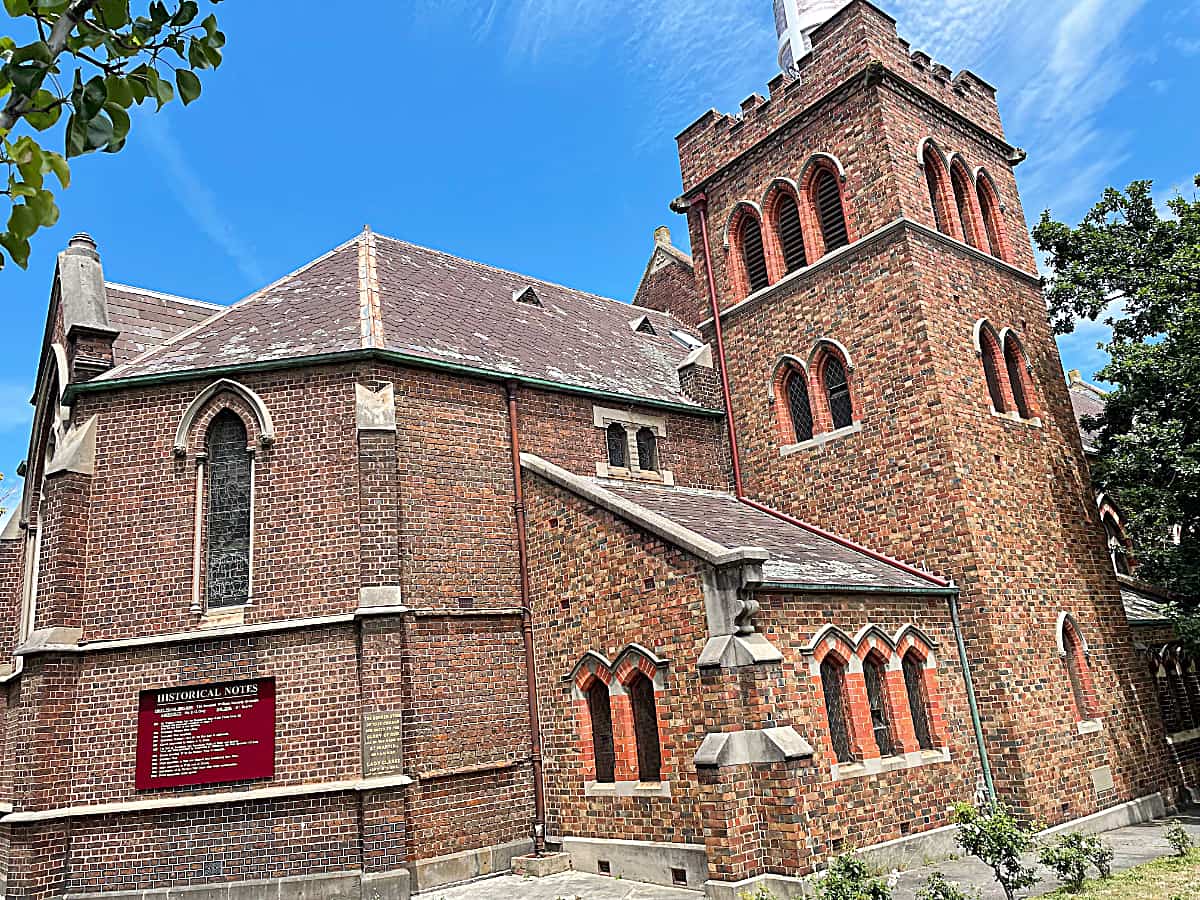
St Martin's Anglican Church, Hawksburn – exterior from the north-east
[photograph by John Maidment (5 December 2023)]
Historical and Technical Documentation by John Maidment
© OHTA (last updated December 2023)

St Martin's Anglican Church, Hawksburn – exterior from the north-east
[photograph by John Maidment (5 December 2023)]
Historical and Technical Documentation by John Maidment
© OHTA (last updated December 2023)
The foundation stone of St Martin's Church was laid on 6 September 1883 by Sir W.J. Clarke representing his wife Lady Clarke.1
The church was designed to accommodate a congregation of 1400 people. The first section that was erected, the chancel, was 50ft long, 32ft wide and 33ft high, and could accommodate 300 people and cost around £2,250 to erect. The architect was Mr E.G. Ovey, of 67 Chancery-lane and the contractor Mr F.W. Beaven, of Prahran. The first section of the building was opened on 14 December 1883. The plan envisaged a tower and spire 156ft high.2 In 1886 a nave capable of accommodating 500 worshippers, together with an organ chamber and baptistery were added to the church.3

St Martin's Anglican Church, Hawksburn – interior from the nave with organ to the right
[photograph by John Maidment (5 December 2023)]
The building is of interest for its High-Victorian Gothic style and use of polychromatic brickwork utilising brown Hawthorn bricks interspersed with cream and red bricks in diaper patterns. The chancel is unusually wide and the nave has a sloping floor. The splendid window behind the high altar was made by Brooks, Robinson and another in the nave by Napier Waller. The wooden reredos was made by the accomplished wood carver Robert Prenzel, whose workshop was nearby in South Yarra.4 The church also has a rare collection of Arundel prints.
A soldier's memorial tower with crenellated top was added to the design of A. &. K. Henderson, Rodney Alsop and Marcus Martin, dedicated on 15 July 1922. It incorporates eight Harrington tubular bells.5


St Martin's Anglican Church, Hawksburn – organ
[photographs by John Maidment (5 December 2023)]
The organ was built by George Fincham and inaugurated on 1 February 1887. It was the firm's first foray into building tubular-pneumatic actions and utilised Hunter's patent. It incorporated one of the firm's standard three-tower cases. It was fully described in The Argus newspaper:
"An inaugural service, on the occasion of the opening of the new organ at St. Martin's Church, Hawksburn, was performed there last night, in which the following choirs took part, namely, those of Christ Church, South Yarra; St. John's, Toorak; Holy Trinity, Balaclava; Christ Church, St. Kilda; St. George's, Malvern; St. Mark's, Fitzroy; and All Saints', St. Kilda. A large congregation filled the church. The new instrument, which has just been completed by Mr. G. Fincham, organ builder, of Richmond, embodies a most important improvement in construction, known as "Hunter's Patent", the right of applying this in Australia being secured to Mr. Fincham. The effect of this is to do away with all levers and movable connections between the key-board and the soundboard. Silent and swift action is secured by attaching a valve-chest to the tail of the key, and a pneumatic apparatus to the sound-board. These two points, no matter where the key-board may be, are connected by tubes, and when the key is touched by the finger pressure is admitted to the tube and transmitted to the end connected with the sound-board. The coupling medium is a contrivance of remarkable ingenuity, and is governed by studs so placed as to be easily moved by the player's thumbs even when his fingers are engaged in working the keys. The pressure of the first stud beneath the keys of the "great organ" bring on dulciana and bourdon; of the second stud clarabella, open diapason and flute; and of the third the full power of that organ. So with the studs of the swell organ, No.1 brings on keraulophon and gedact, No. 2 gemshorn and oboe, No.3 full power with sub-swell to great and super-swell to great. All working parts of the organ move with the least possible resistance. The draw-stops at the sides, which can be used separately, represent open diapason, clarabella, dulciana, octave, flute, twelfth, fifteenth, and trumpet in the "great", and geigen principal, gedact, keraulophon, gemshorn, piccolo, cornopean, and oboe in the "swell". The pedal organ consists of open diapason CCC to F and bourdon, both 16ft. The couplings are swell to great unison, swell to great super, swell to great, sub-swell to pedals, and great to pedals. The position of stops, couplers, studs, &c., lately decided upon by the College of Organists, London, has been adopted. The whole contents of the key-board case shows workmanship of high ingenuity and finish. The general tone of the instrument is very sweet and full, with every gradation of power under instantaneous and easy control. Opening and concluding voluntaries were played by Messrs. Needham and Thomas, and the following organists also took part in the musical performances, namely Messrs. W.H.B. Hailes, Bilton, Dumergue, Stevens, and Knott."6
Around 1952, a second hand Fincham stopkey console, from St Mark's Church, Camberwell, replaced the Fincham original. The pneumatic action was upgraded at the time.
When visited in 1969, it was noted that the organ was very fine tonally and one of the best Fincham organs of the period. The sound was assisted by a broad chancel unencumbered by carpet and a fine resonant acoustic. ABC radio sometimes recorded choral programmes there, conducted by Leonard Fullard, owing to the acoustic and minimal traffic noise.
The specification then was as follows:
| GREAT Open Diapason Claribel Dulciana Octave Flute Twelfth Fifteenth Trumpet Swell to Great |
8 8 8 4 4 2-2/3 2 8 |
||
| SWELL Geigen Principal Gedact Keraulophon Gemshorn Piccolo Cornopean Oboe Sub Octave Super Octave Tremulant |
8 8 8 4 2 8 8 |
gvd.bass |
|
| PEDAL Open Diapason Bourdon Great to Pedal Swell to Pedal |
16 16 |
Compass: 61/30
Tubular-pneumatic action
Detached and reversed stopkey console
Balanced mechanical swell pedal
3 thumb pistons to Great
3 thumb pistons to Swell7
At some stage the original pipe decorations were covered with brass paint.
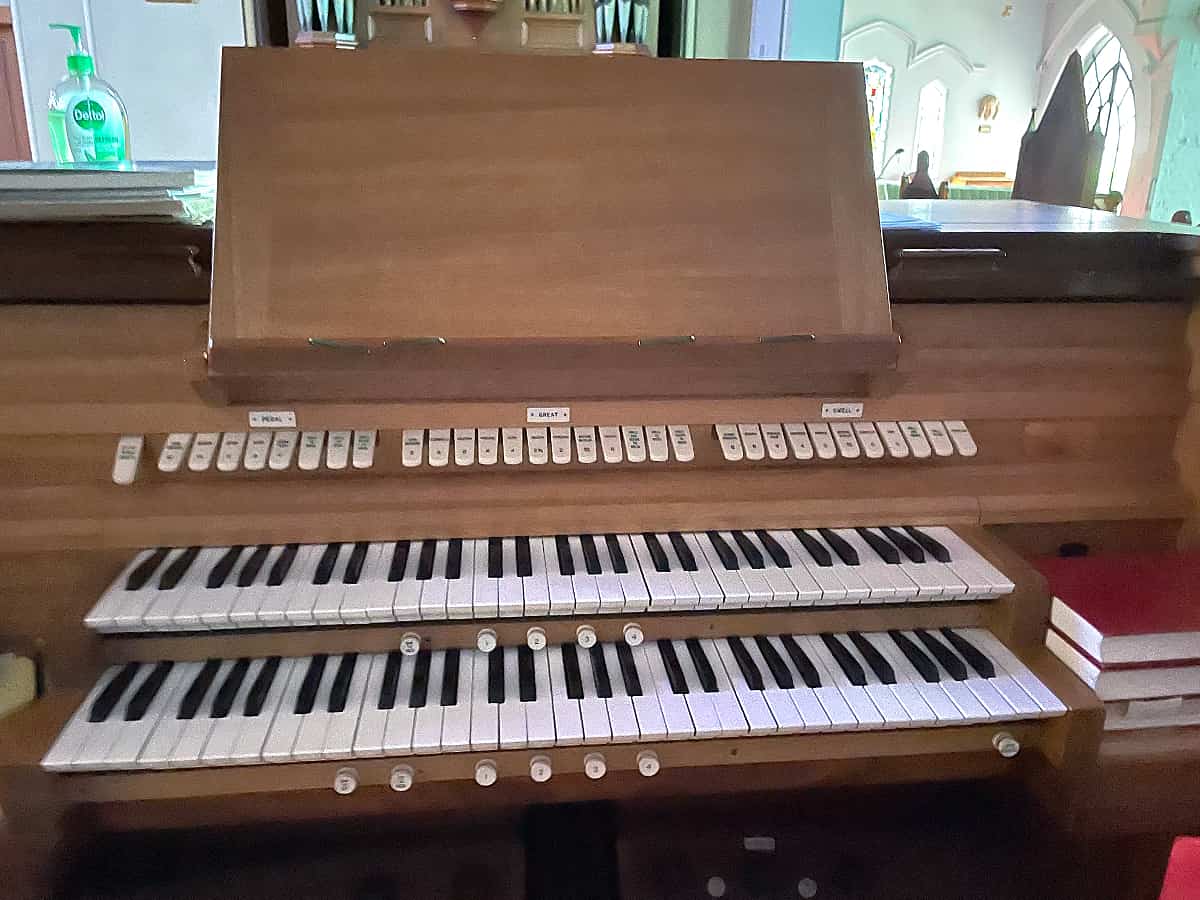
St Martin's Anglican Church, Hawksburn – the 1994 console
[photograph by John Maidment (5 December 2023)]
In 1994 the organ was rebuilt by Australian Pipe Organs Pty Ltd. The organ was moved forwards to the front of the chamber, a new detached stopkey console provided placed on the opposite side of the chancel, the action was electrified, the Great Trumpet hooded, and two tonal additions made, as shown below. The brass paint was stripped from the façade pipes to reveal the original stencilling.
| GREAT Open Diapason Clarabella Dulciana Principal Flute Twelfth Fifteenth Mixture 19.22.26 Trumpet Swell Sub Octave to Great Swell to Great Swell Octave to Great |
8 8 8 4 4 2-2/3 2 III 8 |
added 1994 |
|||
| SWELL Geigen Principal Gedeckt Keraulophon Gemshorn Piccolo Mixture 15.19.22 Cornopean Oboe Swell Sub Octave Swell Octave Tremulant |
8 8 8 4 2 III 8 8 |
gvd.bass added 1994 |
|||
| PEDAL Open Diapason Bourdon Octave Flute Octave Flute Great to Pedal Swell to Pedal Swell Octave to Pedal |
16 16 8 8 4 |
A B A B B |
added 1994 added 1994 added 1994 |
Great & Pedal pistons coupled
Compass: 61/30
Detached stopkey console
Electro-pneumatic action
Balanced electric swell pedal
4 thumb pistons to Great
4 thumb pistons to Swell
4 toe pistons to pedal
Reversible thumb and toe pistons for Swell to Great, Swell to Pedal, Great to Pedal
General cancel thumb piston8
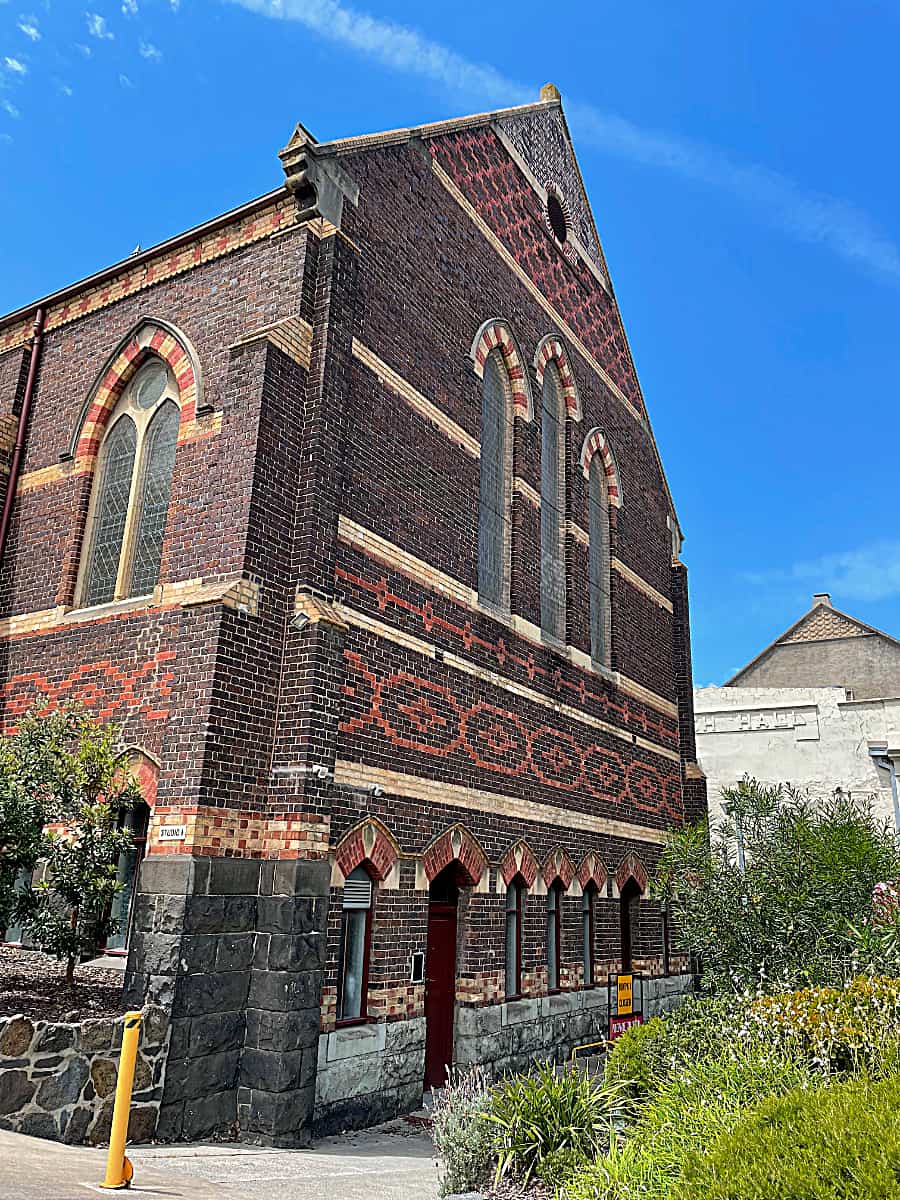
St Martin's Anglican Church, Hawksburn – west wall showing patterned brickwork
[photograph by John Maidment (5 December 2023)]

St Martin's Anglican Church, Hawksburn – foundation stone
[photograph by John Maidment (5 December 2023)]
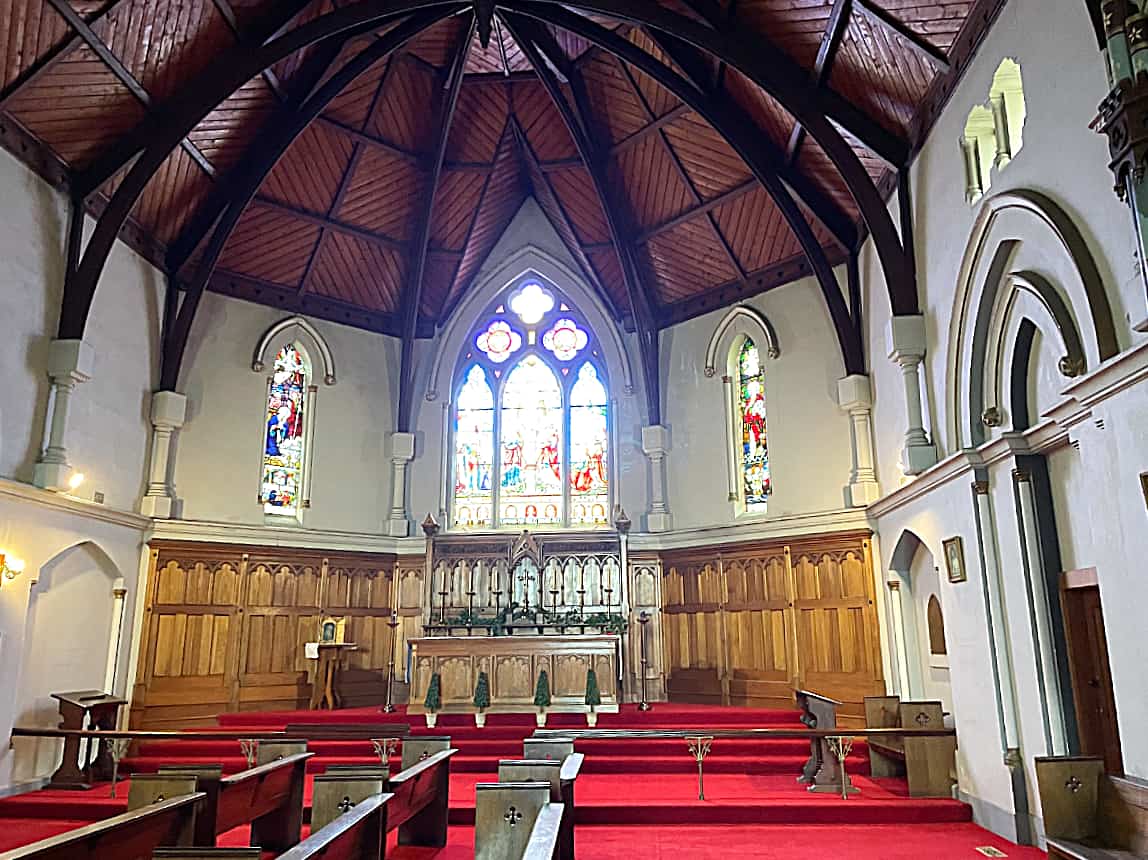
St Martin's Anglican Church, Hawksburn – chancel
[photograph by John Maidment (5 December 2023)]
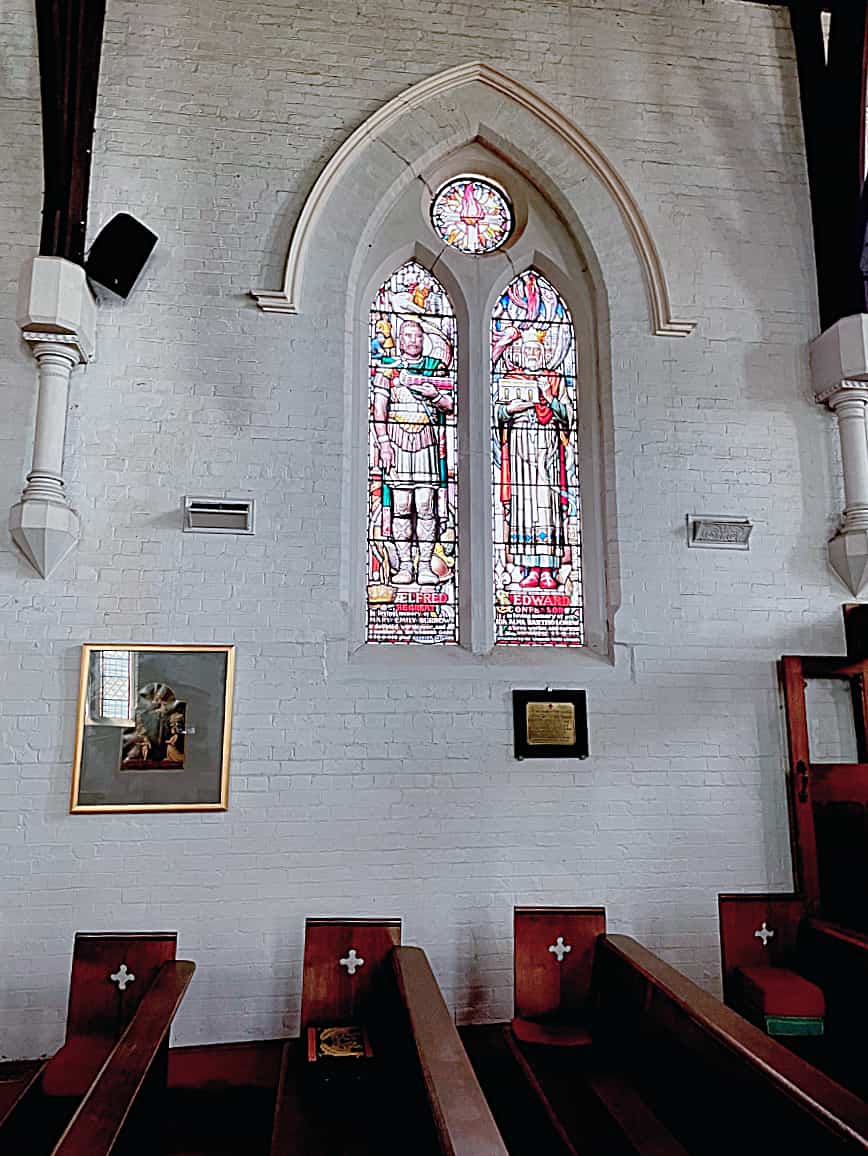
St Martin's Anglican Church, Hawksburn – Napier Waller window and an Arundel print
[photograph by John Maidment (5 December 2023)]
1 The Age, 7 September 1883, p.7
2 The Argus, 14 December 1883, p.9
3 The Telegraph, 27 November 1886, p.6
4 Terence Lane, Robert Prenzel 1866-1941: his life and work. Melbourne: National Gallery of Victoria, 1994, p.43 where it is illustrated
5 Prahran Telegraph, 2 June 1922, p.5 and 21 July 1922, p.5
6 The Argus, 2 February 1887, p.8
7 Specification noted by John Maidment 1966 and 1969
8 Specification noted by John Maidment 1995 and 2023